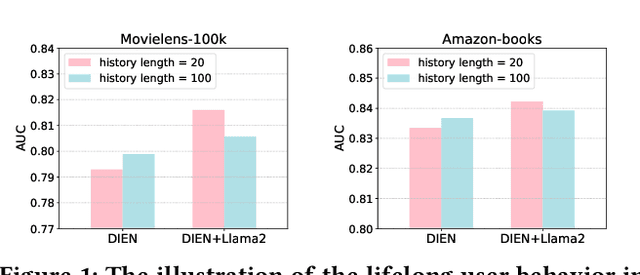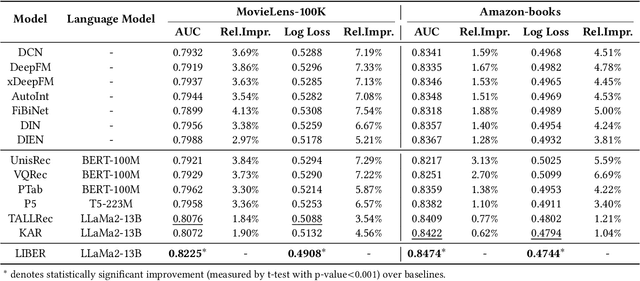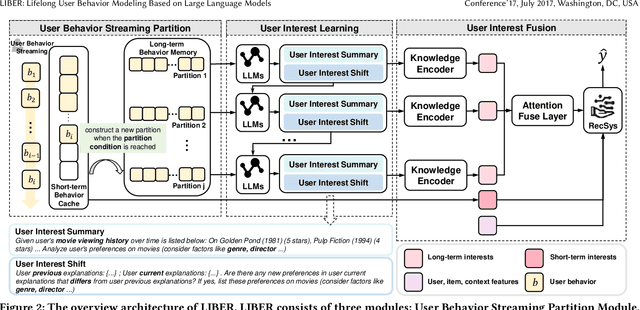Xiangyang Li
MoonCast: High-Quality Zero-Shot Podcast Generation
Mar 19, 2025Abstract:Recent advances in text-to-speech synthesis have achieved notable success in generating high-quality short utterances for individual speakers. However, these systems still face challenges when extending their capabilities to long, multi-speaker, and spontaneous dialogues, typical of real-world scenarios such as podcasts. These limitations arise from two primary challenges: 1) long speech: podcasts typically span several minutes, exceeding the upper limit of most existing work; 2) spontaneity: podcasts are marked by their spontaneous, oral nature, which sharply contrasts with formal, written contexts; existing works often fall short in capturing this spontaneity. In this paper, we propose MoonCast, a solution for high-quality zero-shot podcast generation, aiming to synthesize natural podcast-style speech from text-only sources (e.g., stories, technical reports, news in TXT, PDF, or Web URL formats) using the voices of unseen speakers. To generate long audio, we adopt a long-context language model-based audio modeling approach utilizing large-scale long-context speech data. To enhance spontaneity, we utilize a podcast generation module to generate scripts with spontaneous details, which have been empirically shown to be as crucial as the text-to-speech modeling itself. Experiments demonstrate that MoonCast outperforms baselines, with particularly notable improvements in spontaneity and coherence.
Purest Quantum State Identification
Feb 20, 2025Abstract:Precise identification of quantum states under noise constraints is essential for quantum information processing. In this study, we generalize the classical best arm identification problem to quantum domains, designing methods for identifying the purest one within $K$ unknown $n$-qubit quantum states using $N$ samples. %, with direct applications in quantum computation and quantum communication. We propose two distinct algorithms: (1) an algorithm employing incoherent measurements, achieving error $\exp\left(- \Omega\left(\frac{N H_1}{\log(K) 2^n }\right) \right)$, and (2) an algorithm utilizing coherent measurements, achieving error $\exp\left(- \Omega\left(\frac{N H_2}{\log(K) }\right) \right)$, highlighting the power of quantum memory. Furthermore, we establish a lower bound by proving that all strategies with fixed two-outcome incoherent POVM must suffer error probability exceeding $ \exp\left( - O\left(\frac{NH_1}{2^n}\right)\right)$. This framework provides concrete design principles for overcoming sampling bottlenecks in quantum technologies.
KnowPath: Knowledge-enhanced Reasoning via LLM-generated Inference Paths over Knowledge Graphs
Feb 17, 2025Abstract:Large language models (LLMs) have demonstrated remarkable capabilities in various complex tasks, yet they still suffer from hallucinations. Introducing external knowledge, such as knowledge graph, can enhance the LLMs' ability to provide factual answers. LLMs have the ability to interactively explore knowledge graphs. However, most approaches have been affected by insufficient internal knowledge excavation in LLMs, limited generation of trustworthy knowledge reasoning paths, and a vague integration between internal and external knowledge. Therefore, we propose KnowPath, a knowledge-enhanced large model framework driven by the collaboration of internal and external knowledge. It relies on the internal knowledge of the LLM to guide the exploration of interpretable directed subgraphs in external knowledge graphs, better integrating the two knowledge sources for more accurate reasoning. Extensive experiments on multiple real-world datasets confirm the superiority of KnowPath.
DERMARK: A Dynamic, Efficient and Robust Multi-bit Watermark for Large Language Models
Feb 04, 2025Abstract:Well-trained large language models (LLMs) present significant risks, including potential malicious use and copyright infringement. Current studies aim to trace the distribution of LLM-generated texts by implicitly embedding watermarks. Among these, the single-bit watermarking method can only determine whether a given text was generated by an LLM. In contrast, the multi-bit watermarking method embeds richer information into the generated text, which can identify which LLM generated and distributed a given text to which user. However, existing efforts embed the multi-bit watermark directly into the generated text without accounting for its watermarking capacity. This approach can result in embedding failures when the text's watermarking capacity is insufficient. In this paper, we derive the watermark embedding distribution based on the logits of LLMs and propose a formal inequality to segment the text optimally for watermark embedding. Building on this foundation, we propose DERMARK, a dynamic, efficient, and robust multi-bit watermarking method. DERMARK divides the text into segments of varying lengths for each bit embedding, adaptively matching the text's capacity. It achieves this with negligible overhead and robust performance against text editing by minimizing watermark extraction loss. Comprehensive experiments demonstrate that, compared to the SOTA method, our method reduces the number of tokens required for embedding each bit by 20\%, reduces watermark embedding time by 50\%, and is robust to text editing and watermark erasure attacks.
SampleLLM: Optimizing Tabular Data Synthesis in Recommendations
Jan 27, 2025



Abstract:Tabular data synthesis is crucial in machine learning, yet existing general methods-primarily based on statistical or deep learning models-are highly data-dependent and often fall short in recommender systems. This limitation arises from their difficulty in capturing complex distributions and understanding feature relationships from sparse and limited data, along with their inability to grasp semantic feature relations. Recently, Large Language Models (LLMs) have shown potential in generating synthetic data samples through few-shot learning and semantic understanding. However, they often suffer from inconsistent distribution and lack of diversity due to their inherent distribution disparity with the target dataset. To address these challenges and enhance tabular data synthesis for recommendation tasks, we propose a novel two-stage framework named SampleLLM to improve the quality of LLM-based tabular data synthesis for recommendations by ensuring better distribution alignment. In the first stage, SampleLLM employs LLMs with Chain-of-Thought prompts and diverse exemplars to generate data that closely aligns with the target dataset distribution, even when input samples are limited. The second stage uses an advanced feature attribution-based importance sampling method to refine feature relationships within the synthesized data, reducing any distribution biases introduced by the LLM. Experimental results on three recommendation datasets, two general datasets, and online deployment illustrate that SampleLLM significantly surpasses existing methods for recommendation tasks and holds promise for a broader range of tabular data scenarios.
SyNeg: LLM-Driven Synthetic Hard-Negatives for Dense Retrieval
Dec 23, 2024



Abstract:The performance of Dense retrieval (DR) is significantly influenced by the quality of negative sampling. Traditional DR methods primarily depend on naive negative sampling techniques or on mining hard negatives through external retriever and meticulously crafted strategies. However, naive negative sampling often fails to adequately capture the accurate boundaries between positive and negative samples, whereas existing hard negative sampling methods are prone to false negatives, resulting in performance degradation and training instability. Recent advancements in large language models (LLMs) offer an innovative solution to these challenges by generating contextually rich and diverse negative samples. In this work, we present a framework that harnesses LLMs to synthesize high-quality hard negative samples. We first devise a \textit{multi-attribute self-reflection prompting strategy} to direct LLMs in hard negative sample generation. Then, we implement a \textit{hybrid sampling strategy} that integrates these synthetic negatives with traditionally retrieved negatives, thereby stabilizing the training process and improving retrieval performance. Extensive experiments on five benchmark datasets demonstrate the efficacy of our approach, and code is also publicly available.
Bridging Relevance and Reasoning: Rationale Distillation in Retrieval-Augmented Generation
Dec 11, 2024Abstract:The reranker and generator are two critical components in the Retrieval-Augmented Generation (i.e., RAG) pipeline, responsible for ranking relevant documents and generating responses. However, due to differences in pre-training data and objectives, there is an inevitable gap between the documents ranked as relevant by the reranker and those required by the generator to support answering the query. To address this gap, we propose RADIO, a novel and practical preference alignment framework with RAtionale DIstillatiOn. Specifically, We first propose a rationale extraction method that leverages the reasoning capabilities of Large Language Models (LLMs) to extract the rationales necessary for answering the query. Subsequently, a rationale-based alignment process is designed to rerank the documents based on the extracted rationales, and fine-tune the reranker to align the preferences. We conduct extensive experiments on two tasks across three datasets to demonstrate the effectiveness of our approach compared to baseline methods. Our code is released online to ease reproduction.
LIBER: Lifelong User Behavior Modeling Based on Large Language Models
Nov 22, 2024



Abstract:CTR prediction plays a vital role in recommender systems. Recently, large language models (LLMs) have been applied in recommender systems due to their emergence abilities. While leveraging semantic information from LLMs has shown some improvements in the performance of recommender systems, two notable limitations persist in these studies. First, LLM-enhanced recommender systems encounter challenges in extracting valuable information from lifelong user behavior sequences within textual contexts for recommendation tasks. Second, the inherent variability in human behaviors leads to a constant stream of new behaviors and irregularly fluctuating user interests. This characteristic imposes two significant challenges on existing models. On the one hand, it presents difficulties for LLMs in effectively capturing the dynamic shifts in user interests within these sequences, and on the other hand, there exists the issue of substantial computational overhead if the LLMs necessitate recurrent calls upon each update to the user sequences. In this work, we propose Lifelong User Behavior Modeling (LIBER) based on large language models, which includes three modules: (1) User Behavior Streaming Partition (UBSP), (2) User Interest Learning (UIL), and (3) User Interest Fusion (UIF). Initially, UBSP is employed to condense lengthy user behavior sequences into shorter partitions in an incremental paradigm, facilitating more efficient processing. Subsequently, UIL leverages LLMs in a cascading way to infer insights from these partitions. Finally, UIF integrates the textual outputs generated by the aforementioned processes to construct a comprehensive representation, which can be incorporated by any recommendation model to enhance performance. LIBER has been deployed on Huawei's music recommendation service and achieved substantial improvements in users' play count and play time by 3.01% and 7.69%.
Prompt Tuning as User Inherent Profile Inference Machine
Aug 13, 2024



Abstract:Large Language Models (LLMs) have exhibited significant promise in recommender systems by empowering user profiles with their extensive world knowledge and superior reasoning capabilities. However, LLMs face challenges like unstable instruction compliance, modality gaps, and high inference latency, leading to textual noise and limiting their effectiveness in recommender systems. To address these challenges, we propose UserIP-Tuning, which uses prompt-tuning to infer user profiles. It integrates the causal relationship between user profiles and behavior sequences into LLMs' prompts. And employs expectation maximization to infer the embedded latent profile, minimizing textual noise by fixing the prompt template. Furthermore, A profile quantization codebook bridges the modality gap by categorizing profile embeddings into collaborative IDs, which are pre-stored for online deployment. This improves time efficiency and reduces memory usage. Experiments on four public datasets show that UserIP-Tuning outperforms state-of-the-art recommendation algorithms. Additional tests and case studies confirm its effectiveness, robustness, and transferability.
CoIR: A Comprehensive Benchmark for Code Information Retrieval Models
Jul 03, 2024Abstract:Despite the substantial success of Information Retrieval (IR) in various NLP tasks, most IR systems predominantly handle queries and corpora in natural language, neglecting the domain of code retrieval. Code retrieval is critically important yet remains under-explored, with existing methods and benchmarks inadequately representing the diversity of code in various domains and tasks. Addressing this gap, we present \textbf{\name} (\textbf{Co}de \textbf{I}nformation \textbf{R}etrieval Benchmark), a robust and comprehensive benchmark specifically designed to assess code retrieval capabilities. \name comprises \textbf{ten} meticulously curated code datasets, spanning \textbf{eight} distinctive retrieval tasks across \textbf{seven} diverse domains. We first discuss the construction of \name and its diverse dataset composition. Further, we evaluate nine widely used retrieval models using \name, uncovering significant difficulties in performing code retrieval tasks even with state-of-the-art systems. To facilitate easy adoption and integration within existing research workflows, \name has been developed as a user-friendly Python framework, readily installable via pip. It shares same data schema as other popular benchmarks like MTEB and BEIR, enabling seamless cross-benchmark evaluations. Through \name, we aim to invigorate research in the code retrieval domain, providing a versatile benchmarking tool that encourages further development and exploration of code retrieval systems\footnote{\url{ https://github.com/CoIR-team/coir}}.
 Add to Chrome
Add to Chrome Add to Firefox
Add to Firefox Add to Edge
Add to Edge